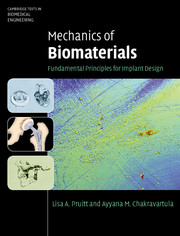Book contents
- Frontmatter
- Contents
- Symbols
- Prologue
- Part I Materials
- Part II Mechanics
- 6 Elasticity
- 7 Viscoelasticity
- 8 Failure theories
- 9 Fracture mechanics
- 10 Fatigue
- 11 Friction, lubrication, and wear
- Part III Case studies
- Epilogue
- Appendix A Selected topics from mechanics of materials
- Appendix B Table of material properties of engineering biomaterials and tissues
- Appendix C Teaching methodologies in biomaterials
- Glossary
- Index
- References
6 - Elasticity
from Part II - Mechanics
Published online by Cambridge University Press: 05 June 2012
- Frontmatter
- Contents
- Symbols
- Prologue
- Part I Materials
- Part II Mechanics
- 6 Elasticity
- 7 Viscoelasticity
- 8 Failure theories
- 9 Fracture mechanics
- 10 Fatigue
- 11 Friction, lubrication, and wear
- Part III Case studies
- Epilogue
- Appendix A Selected topics from mechanics of materials
- Appendix B Table of material properties of engineering biomaterials and tissues
- Appendix C Teaching methodologies in biomaterials
- Glossary
- Index
- References
Summary
Inquiry
What modifications could you make to a hip stem to minimize stress shielding of the surrounding bone while still using metals common to orthopedic implants?
An interesting property of human bones is the manner in which they efficiently build up bone density where the bones are under higher loading, and remove bone density where strength is not needed. This property can be seen in the increased bone strength of the dominant arm of tennis players as compared to the non-racquet-holding arm (Ashizawa et al., 1999). Because the dominant arm is constantly subjected to loading as a result of the impact between the ball and racquet, the bone in that arm has greater bone density than the non-dominant arm, which presumably sees only everyday loading.
This property of bones is of importance to designers of hip stems as it has been shown that patients who have hip implants with a high stiffness stem were experiencing noticeable bone loss. This phenomenon, known as stress shielding, was thought to be occurring because the hip implants themselves were taking up so much of the loading that the body removed from the now extraneous surrounding bone. This in turn led to implant problems, as the remaining bone was not strong enough to stabilize the hip stems, as shown in Figure 6.1. Because of this, researchers turned their attention to developing materials and implants that might provide the same strength and durability with decreased stiffness, forcing the bone to take up more of the load. By the end of this chapter, a method for determining the stresses in various configurations of materials and stem cross-sections, in order to reduce stress shielding, will be developed.
- Type
- Chapter
- Information
- Mechanics of BiomaterialsFundamental Principles for Implant Design, pp. 167 - 207Publisher: Cambridge University PressPrint publication year: 2011



